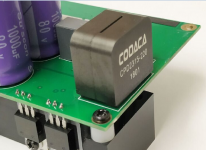I starting this CPD2315S Class D inductor three months ago , it design with Litz wire which would solve heat problem in class D Circuit.
At first using 94-2 and 106-2 Magnetic ring core products is very hot while tried 7G23 but still have high loss , when turn the solution that with Litz wire CPD2315Swould solve the problem beacuse Litz wire would reduce AC losses in high frequency windings.
If the same situation you would try the same .
For more information of CPD2315S . https://codaca.com/en/product/458.html
At first using 94-2 and 106-2 Magnetic ring core products is very hot while tried 7G23 but still have high loss , when turn the solution that with Litz wire CPD2315Swould solve the problem beacuse Litz wire would reduce AC losses in high frequency windings.
If the same situation you would try the same .
For more information of CPD2315S . https://codaca.com/en/product/458.html
Attachments
For better responses, please mention your switching frequency, load current/output power and supply voltage as well.
Yes ,you are right ,the reasons for inductor heating as following:
a. The peak current in the inductor application circuit exceeds the Irms .
b. If for two-in-one inductor heating, the coil and the coil are short-circuited with the magnetic core.
c. The application frequency of the inductor is wrong. (Each core has a suitable application frequency, and the loss is the smallest in this frequency range)
d. Mn-Zn inductors are used in high-voltage circuits greater than 300V. (For example, Mn-Zn inductors may generate heat when applied to half-bridge/full-bridge resonance circuits)
a. The peak current in the inductor application circuit exceeds the Irms .
b. If for two-in-one inductor heating, the coil and the coil are short-circuited with the magnetic core.
c. The application frequency of the inductor is wrong. (Each core has a suitable application frequency, and the loss is the smallest in this frequency range)
d. Mn-Zn inductors are used in high-voltage circuits greater than 300V. (For example, Mn-Zn inductors may generate heat when applied to half-bridge/full-bridge resonance circuits)
